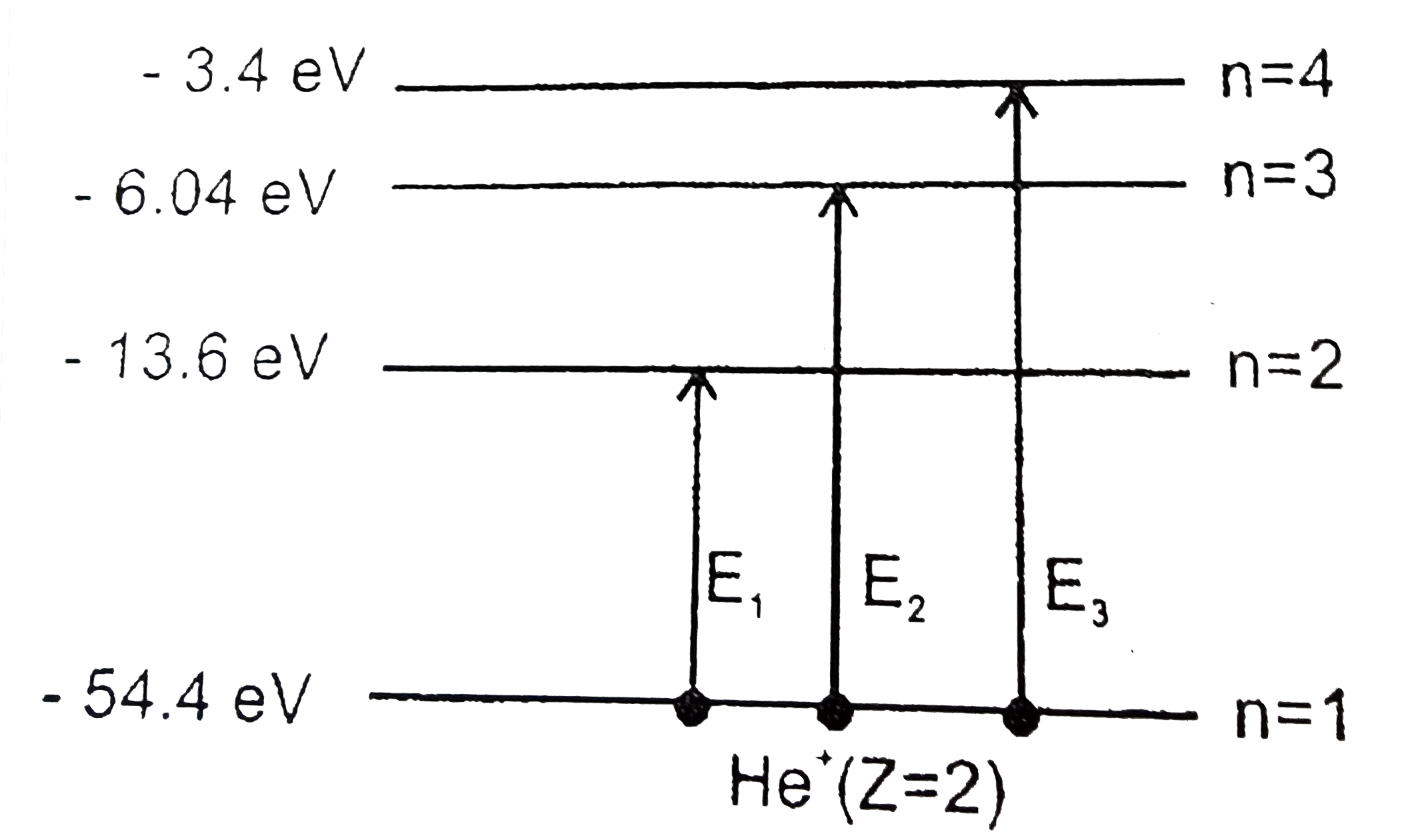A neutron of kinetic 6.5eV collides inelastically with a singly ionized helium atom at rest. It is scattered at an angle 90∘ with respect to its original direction.
Find the maximum allowed value of energy of the He atom?
The correct Answer is:(a) 6.36eV,0.312eV (of neutron), 17.84eV,16.328eV (of atom)
(b) 1.82×1015Hz,11.67×1015Hz,9.84×1015
Let K1 and K2 be the kinectic energies of neutron and helium atom after collision and ΔE be the excitation energy



From conservation of linear momentum along x-direction.
⇒√2Km=√2(4m)K2cosθ(P=√2Km)
Similarly.,applying conservation of linear momentum in y-direction, we have
√2m1m=√2(4m)K2sinθ
Squaring and adding equation (1) and (2), we get
K+K=4K2
or 4K2−K1=K=65eV
Now, during collision, electron cana be excited to any higher energy state. Applying conservation of energy we get K=K1+K2+Δ

or 65=K1+K2+ΔE
ΔE can have the following values,
ΔE1={−13.6−(−54.4)}eV=40.8eV
Substituting in (5), we get
K1+K2=24.2eV
Solving (4) and (6), we get
K1=6.36eV and K2=17.84eV
Similarly, when we put ΔE=ΔE2
{−6.04−(54.4)}eV
in equation (5), we get
K1+K2=14eV
Now, solving (4) and (8), we get
K1=−1.8eV and K2=15.8eV
But since the Kinetic energies cannot have the values, the electron will not jump to third excited state of n=4.
Therefore, the allowed values of K1 ( KE of neutron) are 6.36eV and 0.312eV and of K2 (KE of the atom) are 17.84eV and 16.238eV and the electron can jump upto second exicted state only (n=3)
(b) Possible emission lines are only three as shown in figure. The correspinding frequencies are
V1=(E3−E2)h
={−6.04−(−13.6)}×1.6×10−196.63×10−34Hz
=1.82×1015Hz
V2=E2−E1h
={−6.04−(54.4)}×1.6×101−96.63×10−34Hz
11.67×1015Hz
and V3=E2−E1h
={−13.6−(54.4)}×1.6×10−196.63×10−34Hz
9.84×1015Hz
Hence, the frequencies of emitted radiations are 1.82×105Hz,11.67×1015Hz and 9.84×1015Hz.

Topper's Solved these Questions
- ATOMIC PHYSICSBook:RESONANCEChapter:ATOMIC PHYSICSExercise:Exercise -3 part -I JEE (Advanced)
Explore 86 Videos
- ALTERNATING CURRENTBook:RESONANCEChapter:ALTERNATING CURRENTExercise:HIGH LEVEL PROBLEMS
Explore 11 Videos
- CAPACITANCEBook:RESONANCEChapter:CAPACITANCEExercise:High Level Problems
Explore 16 Videos
Similar Questions
A neutron of kinetic energy 65eV collides inelastically with a single ionized helium atom at rest.It is scattered at an angle of 90∘ with respect of its original direction.
(i) Find the allowed values of the energy of the neutron & that of the atom after collision.
(ii) If the atom gets de-excited subsequently by emitting radiation, find the frequencies of the emitted radiation.
(Given : Mass of the atom =4× ( mass of neutron ) , ionization energy of H atom =13.6eV)
View SolutionA neutron of kinetic energy 65 eV collides inelastically with a singly ionised helium atom at rest. It is scattered at an angle 90∘ with respect to original direction. If the energy of scattered neutron is 6.36 eV, find the frequency of emitted radiation from the helium atom after suffering collision.
View Solution
Knowledge Check
A neutron of kinetic 6.5eV collides inelastically with a singly ionized helium atom at rest. It is scattered at an angle 90∘ with respect to its original direction.
Find the minimum allowed value of energy of the neutron.A0.39eVB0.32eVC0.25eVD0.43eVA neutron having kinetic energy E0 collides with singly ionised He atom at rest and move along initial direction. Which of the following statement(s) is/are true for the above mentioned collision.
ACollision will be perfectly inelastic if E0=17eVBCollision will be perfectly inelastic is E0=8.16eVCIf E0= then ploton of wavelength λ=500m is observed just after the collision if E0=8.16eV.DPerfectly elastic collision is not possible.A neutron in a nuclear reactor collides head on elastically with the nucleus of a carbon atom initially at rest. The fraction of kinetic energy transferred from the neutron to the carbon atom is
A1112B211C48121D48169
A hydrogen atom in ground state is moving with a kinetic energy of 30 eV. It collides with a deuterium atom in ground state at rest. The hydrogen atom is scattered at right angle to its original line of motion. Assume that energy of nth state in both the atoms is given by En=−13.6n2eV and the mass of deuterium is twice that of hydrogen. Write the maximum and minimum possible kinetic energy of deuterium after collision.
View SolutionA photon of energy 10.5eV is allowed to interact with a hydrogen atom in its ground state. Then :
View SolutionA neutron with an energy of 4.6MeV collides elastically with proton and is retarded. Assuming that upon each collision the neutron is deflected by 45∘, find the number of collisions which will reduce its energy to 0.23eV.
View SolutionA neutron having kinetic energy 12.5eV collides with a hydrogen atom at rest negect the difference in mass between the neutron and the hydrogen atom and assume that the neutron does not leave its of motion find the posible kinetic energy of the neutron after the event
View SolutionA neutron collides elastically with an initially stationary deuteron. Find the fraction of the kinetic energy lost by the neutron (a) in a head-on collision , (b) in scattering at right angles.
View Solution